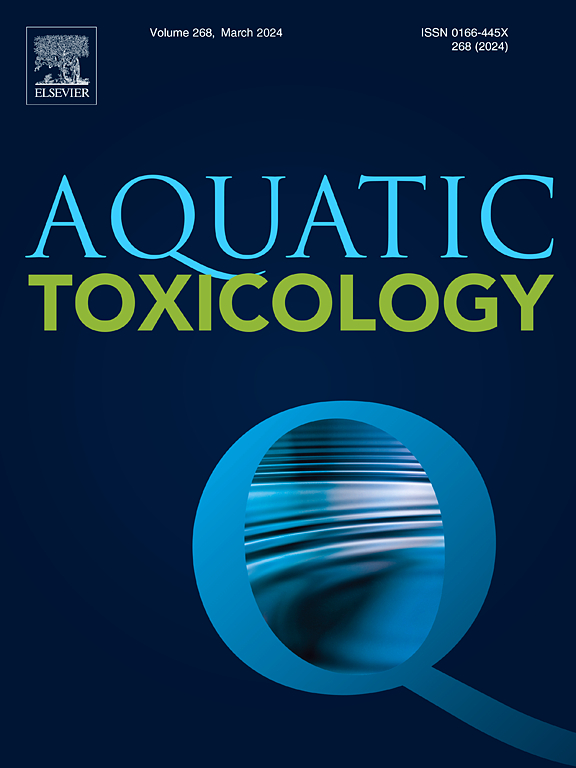Toxicokinetic and liver proteomic study of the Chinese rare minnow (Gobiocypris rarus) exposed to F-53B
IF 4.1
2区 环境科学与生态学
Q1 MARINE & FRESHWATER BIOLOGY
引用次数: 0
Abstract
Perfluorooctane sulfonic acid (PFOS) and its alternative 6:2 chlorinated polyfluoroethersulfonate (6:2 Cl-PFESA, also known as F-53B), are frequently detected in a variety of environmental and human samples. These substances have been associated with hepatotoxic effects, including disorders in lipid metabolism and oxidative stress. However, the molecular mechanisms underlying the causal relationship between exposure to F-53B and hepatotoxicity remain inadequately understood. This study investigated the toxicokinetics and mechanisms of hepatotoxicity associated with prolonged exposure to F-53B in adult Chinese rare minnows. Specifically, 5-month-old adult Chinese rare minnow was exposed to concentrations of 10 μg/L and 200 μg/L of F-53B for a duration of 28 days for bioaccumulation assessment, followed by a 14-day period for metabolic evaluation. The findings indicated that the bioaccumulation of F-53B in the tissues was positively correlated with the exposure concentrations. The logarithmic bioconcentration factor (Log BCF28d) was determined to be 2.67 ± 0.02 for the low concentration group and 2.27 ± 0.01 for the high concentration group. The calculated half-lives (t1/2) were 18.50 ± 1.67 days and 21.38 ± 0.31 days for the respective concentration groups. F-53B protein exhibited a distinct tissue-specific distribution in adult Chinese rare minnow, with the following order of enrichment: Blood > Liver > Gonad > Gill > Intestine > Brain > Muscle. F-53B was primarily concentrated in the blood and liver, where the protein content was significantly higher. Exposure to F-53B for 28 days significantly elevated biochemical levels associated with lipid metabolism and increased the activities of the enzymes FAS, PPARα, and ACC in the liver. This exposure also resulted in impairment of the hepatic oxidative system in the Chinese rare minnow, with F-53B significantly reducing most of the measured markers related to oxidative stress (e.g., GSH, SOD, CAT, and MDA). Proteomic analysis indicated that the toxicity of F-53B regulates the expression of proteins across several functional classes. Based on the functional information of the differential proteins provided in UniProt and KEGG, they were categorized into five main categories: Cellular Processes, Environmental Information Processing, Genetic Information Processing, Metabolism, and Organismal Systems. This study indicate that F-53B is bioaccumulative and persistent in Chinese rare minnow, and can further induce oxidative stress and lipid metabolism disorders. Combined with proteomic research methods, the toxicological effects of F-53B on Chinese rare minnow can be better explained.
暴露于F-53B的中国稀有鲦鱼(Gobiocypris rarus)的毒性动力学和肝脏蛋白质组学研究
在各种环境和人体样本中经常检测到全氟辛烷磺酸(PFOS)及其替代品6:2氯化多氟醚磺酸(6:2 cl - PFOS,也称为F-53B)。这些物质与肝毒性作用有关,包括脂质代谢紊乱和氧化应激。然而,暴露于F-53B和肝毒性之间因果关系的分子机制仍未得到充分的了解。本研究探讨了长时间暴露于F-53B的中国珍稀成年鲦鱼的毒性动力学和肝毒性机制。具体来说,5个月大的中国珍稀成年鲦鱼暴露于浓度分别为10 μg/L和200 μg/L的F-53B中28天,进行生物积累评估,随后进行14天的代谢评估。结果表明,F-53B在组织中的生物积累与暴露浓度呈正相关。测定低浓度组的对数生物浓度因子(Log BCF28d)为2.67±0.02,高浓度组为2.27±0.01。计算的半衰期(t1/2)分别为18.50±1.67天和21.38±0.31天。F-53B蛋白在成鱼中有明显的组织特异性分布,富集顺序如下:血液;肝脏在性腺祝辞吉尔比;肠比;大脑比;肌肉。F-53B主要集中在血液和肝脏中,蛋白质含量明显较高。暴露于F-53B 28天显著提高了与脂质代谢相关的生化水平,增加了肝脏中FAS、PPARα和ACC酶的活性。这种暴露也导致中国稀有鲦鱼的肝脏氧化系统受损,F-53B显著降低了大多数与氧化应激相关的测量标志物(例如,谷胱甘肽、SOD、CAT和MDA)。蛋白质组学分析表明,F-53B的毒性调节了几个功能类蛋白的表达。根据UniProt和KEGG提供的差异蛋白的功能信息,将它们分为五大类:细胞过程、环境信息处理、遗传信息处理、代谢和有机系统。本研究提示F-53B在中国稀有鲦鱼体内具有生物蓄积性和持久性,可进一步诱导氧化应激和脂质代谢紊乱。结合蛋白质组学研究方法,可以更好地解释F-53B对中国珍稀鲦鱼的毒理学效应。
本文章由计算机程序翻译,如有差异,请以英文原文为准。
求助全文
约1分钟内获得全文
求助全文
来源期刊

Aquatic Toxicology
环境科学-毒理学
CiteScore
7.10
自引率
4.40%
发文量
250
审稿时长
56 days
期刊介绍:
Aquatic Toxicology publishes significant contributions that increase the understanding of the impact of harmful substances (including natural and synthetic chemicals) on aquatic organisms and ecosystems.
Aquatic Toxicology considers both laboratory and field studies with a focus on marine/ freshwater environments. We strive to attract high quality original scientific papers, critical reviews and expert opinion papers in the following areas: Effects of harmful substances on molecular, cellular, sub-organismal, organismal, population, community, and ecosystem level; Toxic Mechanisms; Genetic disturbances, transgenerational effects, behavioral and adaptive responses; Impacts of harmful substances on structure, function of and services provided by aquatic ecosystems; Mixture toxicity assessment; Statistical approaches to predict exposure to and hazards of contaminants
The journal also considers manuscripts in other areas, such as the development of innovative concepts, approaches, and methodologies, which promote the wider application of toxicological datasets to the protection of aquatic environments and inform ecological risk assessments and decision making by relevant authorities.
 求助内容:
求助内容: 应助结果提醒方式:
应助结果提醒方式:


